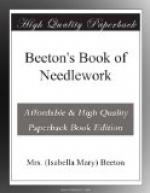* * * * *
ILLUSTRATION 589.—The raised or velvet stitch is worked over small round wooden meshes, and forms small raised loops. Take 2 similar meshes and as many threaded needles as there are colours in the work; make first a slanting stitch, as for the beginning of the common cross stitch, but instead of drawing out the needle straight under the place where it was inserted, draw it out exactly at the same place, so as to form a slanting stitch on the right and on the wrong side; then begin to work over 1 mesh; insert the needle above it and draw it out in a slanting direction underneath. On the wrong side of the work a regular cross stitch is formed. Illustration 589 shows 2 rows of velvet stitch completed and 2 rows being worked; the first of the latter is yet on the mesh, the second being worked so as to show the position of the wool upon the mesh. Observe that the rows of the velvet stitch are worked upwards, and that 2 meshes are necessary, because the lower one must not be drawn out before the next row is completed. The loops may be cut open if preferred.
[Illustration: 589.—Raised or Velvet Stitch.]
* * * * *
[Illustration: 590.—Plaited Stitch.]
ILLUSTRATION 590.—The plaited stitch is worked like the herring-bone stitch. Each stitch is worked over 4 threads in height and 4 in width. Illustration 590 shows one part of the plaited stitch completed, and the place where the needle is to be inserted for the next stitch is marked by a dot. For the next stitch the needle is carried under the 2 threads below the stitches of the preceding row.
* * * * *
ILLUSTRATION 591.—The plush stitch is also worked upwards. Begin to work a common cross stitch, then insert the needle through the canvas over 2 threads in height and 2 in width, downwards in a slanting direction. Do not draw the wool close up, but leave a loop hanging down about four-fifths of an inch long, and make 1 more common cross stitch to fasten the loop. This stitch can also be worked over flat meshes. Work a common cross stitch at the end of every row. When the work is completed the loops are cut open and clipped, as may be seen from illustration.
[Illustration: 591.—Plush Stitch.]
* * * * *
ILLUSTRATIONS 592 to 594.—Three Berlin wool work borders for trimming baskets, &c. No. 592.—The 2 outer rows which edge the border are worked in long straight cross stitch; each stitch is crossed in the centre with a back stitch.
[Illustration: 592.—Berlin Work Border.]
The grounding consists of 2 rows of vandykes placed opposite each other, which are formed of long straight stitches of different lengths. The squares in the centre are formed in the same way, and are completed in the middle with a knot. No. 593.—The ground is worked in cross stitch, the raised patterns in satin stitch; in the middle of each pattern there is a cross stitch. The outer rows are worked in half cross stitch over 2 threads in height and 4 in width in 2 different shades. No. 594.—The petals of the flowers are worked over 4 threads in height and in width, and consisting of 4 slanting stitches.




